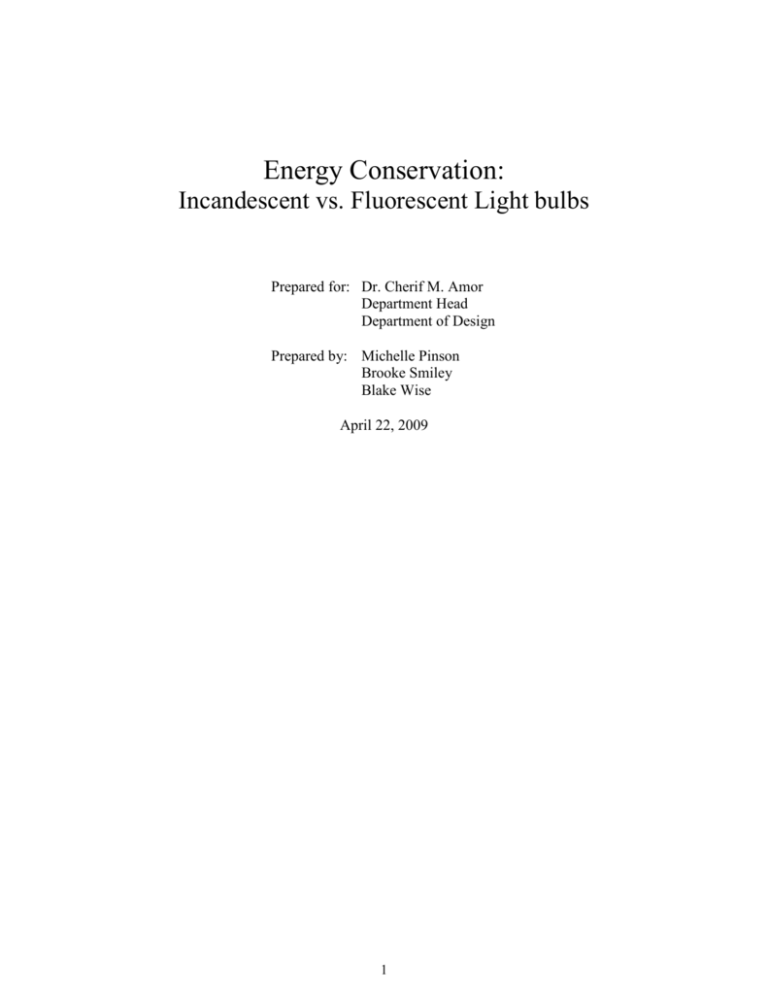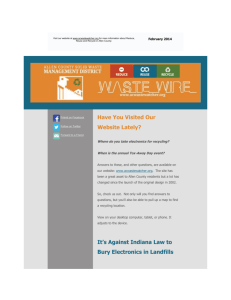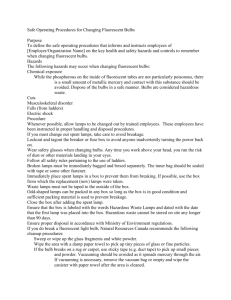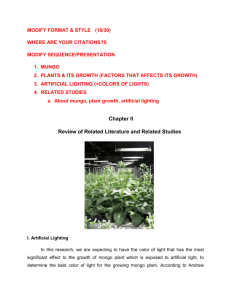
Energy Conservation:
Incandescent vs. Fluorescent Light bulbs
Prepared for: Dr. Cherif M. Amor
Department Head
Department of Design
Prepared by: Michelle Pinson
Brooke Smiley
Blake Wise
April 22, 2009
1
Letter of Transmittal
Michelle Pinson
Brooke Smiley
Blake Wise
English 2311.006
April 6, 2009
College of Human Sciences
Texas Tech University
P. O. Box 41220
Lubbock, TX 79409
Attention: Cherif Amor, Chair of Department of Design
Subject: Energy Conservation Project Proposal
We are Texas Tech students interested in energy conservation. Our proposal, “Energy
Conservation: Incandescent versus Fluorescent light bulbs,” suggests that Fluorescent lighting is
more energy efficient than Incandescent bulbs. Our research for this proposal has been done
specifically to the Human Sciences building.
We are proposing that the incandescent bulbs in the Human Sciences building be replaced with
fluorescent light bulbs. We believe that changing out the bulbs will conserve energy and save
money. It will also help the school to keep up in a time when conserving our natural resources is
very important, and there is a strong emphasis to “Go Green.” The positive results from this
change should be convincing enough to eventually do the same to every building on campus.
This proposal will hopefully convince you to present this information to the manager of Facilities
Planning and Construction. This will appeal to the manager because it will save the university
money and reduce the number of times the bulbs have to be changed per year. The information
will have a greater impact coming from you because of your position and your experience in
design.
Let us know if you have any questions regarding our proposal.
Sincerely,
Michelle Pinson
Brooke Smiley
Blake Wise
Enclosures
2
Abstract
“Energy Conservation: Incandescent versus Fluorescent Light bulbs”
Prepared by: Brooke Smiley, HDFS
Michelle Pinson, Interior Design
Blake Wise, Landscape Architecture
Energy Conservation is an important issue throughout the world. Most recently, there
have been numerous developments pertaining to lighting and ways to conserve energy.
Texas Tech has started the process of becoming more environmentally friendly, but there
is still a lot of progress to be made.
One important way to accomplish energy conservation is the use of fluorescent light
bulbs as opposed to incandescent. Currently, Texas Tech University is using the
incandescent bulbs in the largest majority of classrooms and buildings. The purpose of
this report is to purpose the idea of making Texas Tech more “green” by using more
environmentally friendly fluorescent bulbs. Not only are these not cost effective, but
they are extremely energy consuming and impractical.
3
Table of Contents
1.
2.
3.
4.
5.
6.
7.
8.
9.
10.
11.
Letter of transmittal
Abstract
Glossary of terms
Figures
Introduction
a. Background
b. Problem
c. Solution
d. Criteria
e. Purpose statement
f. Overview of other information
Background Information on Light bulbs
Experimentation in the Human Sciences Building
a. Survey
b. Replacement of bulbs
Conclusion/ Recommendations
Qualifications and Experience
References
Appendix
4
Glossary
ar∙gon - n. A colorless, gaseous element
present in the atmosphere, used
in electric display signs and as a
filter for incandescent lamps.
the air form reaching the hot
filament. Sometimes called
electric lamps.
i∙on∙ize – To convert or be converted, totally
or in part, into ions, electrically
charged atoms.
e∙lec∙trode - n. 1. Any terminal connecting
a conductor, as copper wire,
with an electrolyte. 2. Any
elements in an electron tube,
transistor, etc., that emit, collect,
or control movements of
electrons.
mer∙cu∙ry – n. 1. A heavy, silver-white,
metallic element (Hg), liquid at
ordinary temperatures.
phos∙phor – Any of a class of substances
that will emit light under the
action of certain chemicals or
radiations.
fil∙a∙ment - n. 1. A fine thread fiber, any
threadlike structure or
appendage. 2. The slender wire
of tungsten, carbon, etc., which
when heated by electric current
in a vacuum produces light.
ra∙di∙a∙tion – n. The emission and
propagation of radiant energy,
esp. by radioactive substances
capable of effecting living
tussue.
fluor∙es∙cent lamp – A tubular lamp in
which ultraviolet light from a
low-pressure mercury arc is
radiated as visible light after
impact upon a coating of
phosphors.
tung∙sten – n. A steel-gray, brittle, heavy
metallic element of chromium
group having a high melting
point and much used in
manufacture in filaments for
electric lamps and high speed
tools.
in∙can∙des∙cent lamp - A lamp having a
filament that is heated to
incandescence, a general term
for heat driven light emissions
which includes the simple case
of black body radiation, by an
electric current. The enclosing
gas bulb prevents the oxygen in
volt∙age – n. Electromotive force
compressed in volts, units of
force against the resistance of
on ohm.
Funk & Wagnall’s Standard Desk Dictionary.Funk & Wagnall.New York.1984
5
Introduction
Background:
Energy Conservation is becoming very important to everyone in the world. In Texas, there are a
number of people and businesses going “green,” and efforts have been made to come up with
new methods of conserving energy. One method is using fluorescent lighting to replace
incandescent lamps. This lighting method of energy conservation is a good way to start
becoming more environmentally friendly. Texas Tech University has made efforts to become
more environmentally friendly and lower costs of electricity. Changing out the lights in the
buildings on campus would conserve energy and significantly lower electricity costs.
Problem:
We are presenting the problem of energy conservation. We are seeking the approval to propose
the idea to switch from fluorescent light bulbs to incandescent bulbs in the Human Sciences
building of Texas Tech University to cut high electric costs. Switching from incandescent bulbs
to fluorescent bulbs in one building will show how much money can be saved. This will
hopefully be convincing enough to eventually change the bulbs in every building and becoming
more environmentally friendly.
Purpose:
This report explains why you should consider presenting over the costs and benefits of switching
light bulbs campus wide to more energy efficient bulbs to Jamie McCann the manager of Texas
Tech Facilities Planning and Construction. As students, we don’t have the credibility to present
this information ourselves.
We feel you are the best candidate to present this information because you hold such an
important position within the Human Sciences Building and because you have extensive
background knowledge in environmental design. You have also shown interest in “green”
design which has become popular over recent years.
Sources of Information:
In this report you will find research, analysis, experimentation, results, and our proposed
solutions. We have researched many different sources including the Encarta Encyclopedia,
Energy Star website, and Nexis Lexis. We have explained the cost and benefits of our proposal,
and we have conducted a survey to show that there are many other people that want to conserve
energy.
Scope of Proposal:
This report is not proposing to try and conserve energy throughout the entire campus but just to
the Human Sciences building. We feel this is a good place to start and will have convincing
results. This is just one of many ways to help conserve energy in the building. This proposal is
practical and would be worth accepting.
6
Research
This section of the report is all basic research and information over incandescent and fluorescent
light bulbs. I am aware that you already know this information, but I am giving it to you so it
will be easy to present to people who are less informed.
Incandescent bulbs
Currently, the largest majority of Texas Tech buildings use incandescent bulbs. An incandescent
bulb, by definition, is a bulb that heats up to an extremely high temperature. They usually have
tiny coiled tungsten filaments inside of a bulb filled with gas. When electricity moves through
the filaments, they heat up to around 5000°F. This causes the filament to glow. A typical bulb
lasts approximately 750-1000 hours.
Incandescent bulbs are not typically considered energy efficient. In fact, in 2007 the United
States Congress passed the Energy Independence and Security Act that. This act will eventually
eliminate the use of all incandescent light bulbs. As of 2012, incandescent bulbs will no longer
be sold, and by 2014 they will be completely eliminated.1
OPPORTUNITY FOR MORE INFORMATION ^ about bill
Fluorescent bulbs
Fluorescent bulbs are an alternative to incandescent bulbs. One major difference is fluorescent
bulbs don’t emit heat. They instead use phosphors that emit light when they are exposed to
radiation. They are glass tubes filled with argon, mercury, and the tube is coated with phosphors.
At the ends of the tubes are metal electrodes. Each of the metal electrodes are coated with
oxygen and an alkaline earth metal. A surge of voltage is sent throughout the tube and ionizes
the gas. When the current passes through the gas, ultraviolet radiation is emitted. The
phosphorus coating inside the tube stops and converts the energy into visible light.
Typically speaking, fluorescent bulbs “use 75% less electricity and last 10 times longer than
regular incandescent light bulbs.”2 According to the Department of Energy, “if every household
replaced just one light bulb with a compact fluorescent, the United States would save more than
$600 million each year in energy costs and prevent greenhouse gas emissions equal to 800,000
cars.” Unfortunately, there are a few negatives to fluorescent bulbs. First, they are typically
more expensive than a regular incandescent bulb. According to the EnergyStar website,
fluorescent bulbs cost anywhere from $2 to $15. However, they will save you around $30 during
their “life cycle.” 3
Another common criticism of fluorescent bulbs is that the color spectrum is relatively limited by
comparison to the incandescent bulbs. Because light bulbs are trying to mimic the sun, it is
1
Encarta – incandescent, viewed on march 31st, "Incandescent Lamp," Microsoft® Encarta® Online
Encyclopedia 2008 http://encarta.msn.com
2 "Fluorescent Lamp," Microsoft® Encarta® Online Encyclopedia 2008
http://encarta.msn.com © 1997-2008
3
http://energystar.custhelp.com/ FAQ
7
almost impossible for the color spectrum to be absolutely complete. Energy star is now coming
out with a variety of bulbs covering several hues.4
Other Universities
There have been several universities who have started replacing bulbs to become more energy
efficient. One example of this is at the University of California in the Center for the Performing
Arts’ parking structure. The new bulbs (BetaLED bulbs) reduce energy consumption by 80%.
Because these bulbs have such a long life-span, they will not require maintenance for 20 to 25
years.5
Pomona College is located in Claremont, California. Although this private college has not made
the complete transition to all fluorescent bulbs, it is giving it’s students the opportunity to use
them in the dorms. A student named Michael Blouin recently started a CFL (compact
fluorescent light) checkout program. Now, any student can individually make an impact by
checking out a CFL bulb to use in their room (paid for by a portion of their tuition).6 During a
“lighting audit” 2,564 incandescent bulbs were found. It was calculated that if these bulbs were
changed, it would save “approximately 511,128 kWh/year in electricity and $56,000 per year in
utility costs.”7
http://www.energystar.gov/index.cfm?c=cfls.pr_cfls_color
Nexis Lexis “college university light energy” Biotech Business Week, jan 26, 2009
6 http://www.pomona.edu/sustainability/programs-projects/energy.shtml
7 http://www.pomona.edu/sustainability/audit-action-plan/audit/AuditPDFs/13%20-%20Lighitng.pdf
4
5
8
Procedure
This section of the report describes a possible experiment that could prove the benefits of
replacing the bulbs. This information would be useful to the proposed audience (Facilities
Planning and Construction).
Human Sciences Building
We would need a building to begin an experiment to prove why changing the bulbs would be
beneficial. Your building would be an ideal place to begin the experiment because:
You have so much knowledge in the area of lighting and environmental design. This
would be helpful because you could act as an advisor.
The Human Sciences Building currently uses incandescent bulbs.
There are many graduate students, who you advise, that would be ideal candidates for the
experiment. Graduate students always need research opportunities.
First, the students would have to obtain permission from the Dean of the College to do the
experiment. Her name is Linda Hoover and the Dean’s Office number is (806) 742-3031. The
student(s) would need a map of the college, a master key, and schedule of when each of the class
rooms are available. They would also need to have a general idea of how long each of the rooms
are lit.
Experiment
The most time consuming part of this experiment would be to accurately determine the number
of bulbs. It would be important to note if they are pot lights, 2’ incandescent tubes, 4’
incandescent tubes or possibly a fluorescent bulb. This will be vital to accurately determining
the cost of lighting in the building.
To determine the cost of lighting the building with incandescent bulbs, the student would need to
gather records from the dean’s office. From these they can determine the cost per hour as
established by the electric company. Next, the information would simply be inputted into a basic
equation to determine to cost using incandescent bulbs:
Enter equation here.
To calculate the approximate cost of electricity per month using fluorescent bulbs, the
information could be inputted into the following equation:
Enter equation here.
Survey
We have created a survey, and it was given to the students living in and the staff working in the
Pomona College in Claremont, California. The questions were:
1. Do you have a preference between incandescent and fluorescent bulbs?
2. Did you notice a general difference between fluorescent bulbs and incandescent bulbs?
9
3. Would you consider changing them at your personal residence?
4. Did you notice any physical changes while using the fluorescent bulbs?
5. Did your room/office seem cooler with the replacement of the bulbs?
10
Recommendations
On the basis of our conclusions, we recommend the following(from the book):
1.
2.
3.
And why…. What are we saying this
11
Qualifications and Experience
We believe, as a group, that we have the skills and resources to complete this research. Because
of our diverse backgrounds, we have a sufficient amount of knowledge in this area. Coming all
of our strengths will help us to thoroughly complete the proposal.
Michelle Pinson is studying interior design and architecture. She came up with the initial idea
and gives guidance. During her time as a student, she has taken a lighting course. She also has a
significant amount of computer knowledge. This has helped significantly reduce formatting
time. She also has access to the Human Sciences building, which is an important resource for
our experiment.
Brooke Smiley is studying Human Development Family Studies. Because of her background,
she has developed good communication skills
Blake Wise is studying Landscape Architecture. He is interested in energy conservation and takes classes
that research ways to conserve energy and protect the environment. Although most of his studies are over
plants and the environment, the concept of conservation is the same. Having interest in this area will help
him to come up with ideas and have input on the proposal. He also has a fair amount of computer
knowledge and understands how to transfer and share information with others.
12
References
Energy star
Lexus-nexus
Articles
13
Appendix
Appendix: present our primary research results
“EXTRA” info
Information that is useful for the audience, but would interrupt the flow of the report
Information that helps to establish your credibility (like show how much work you did)
Examples or other things for the audience to use
14
Survey for 100 students & 100 faculty members
category
student
faculty
Incandescent bulbs
Fluorescent bulbs
24
17
No preference
49
54
15
27
29
BYLINE: BROWN Giles
SECTION: NEWS; NATIONAL; NEWS; Pg. 2
LENGTH: 408 words
Canterbury residents are questioning the safety of energy-saving lightbulbs
after they shattered or burnt out in their homes.
Their concerns follow a fire in a Wellington apartment building last Friday that
began near a spiral lightbulb.
The Fire Service has not determined whether the fire was caused by the bulb, and
the Energy Efficiency Conservation Authority insists the fluorescent bulbs are safe.
Sue Dillon, 63, who lives near Selwyn, said her family meal was spoilt when an
energy-saving bulb exploded and showered glass onto the dinner table.
"The point is a lightbulb, for safety reasons, shouldn't be doing that. I wouldn't
have liked to have a child crawling around," she said.
Epileptic Philip Haythornthwaite said he was "lucky to have avoided a fire" at his
Shirley home after two of the bulbs suddenly overheated.
Haythornthwaite, 49, was suffering from a seizure at the time but came round to
find bulbs in his living room and hallway had overheated and blackened "virtually
simultaneously".
The incident spurred him to send an email around the offices of charity Epilepsy
New Zealand warning members not to use them.
"I am very, very concerned for people who have a disability and that we will have
something coming into the house which is not reliable," he said. "I think it could
have been very dangerous and I think I am lucky I am still here and the house did
not go up in smoke."
Energy Safety spokeswoman Julie Allan said the agency had received 100 calls on
energy-saving lightbulbs this month.
16
"About a third are related to what people think are safety issues relating to smoke
and blackening," she said.
No structural fires had been linked to the bulbs.
Massey University senior lecturer in illumination engineering Roy Speed said the
bulbs were safe statistically.
"Something like 13 million have been sold and we are barely out of single figures in
terms of reported problems," he said. "I think people could be being hypersensitive
because they are something new."
Speed said energy-saving bulbs could fail for the same reasons that caused
incandescent bulbs to "pop".
"Whether it is a conventional bulb or whatever, there is the potential for that to
happen," he said.
Technological reasons also meant energy-saving bulbs could shatter if they were
used with dimmer devices, although bulbs were coming on the market that were
compatible.
The Government has announced imports of incandescent lightbulbs will be
stopped in October 2009.
Find Documents with Similar Topics
Help
Below are concepts discussed in this document. Select terms of interest and either modify your search or
search within the current results set
Industry
ENERGY EFFICIENCY &
CONSERVATION
Subject
ENGINEERING
ENGINEERING
Minor Terms
ENERGY DEVELOPMENT
PROGRAMS
Geography
Minor Terms
EPILEPSY
ELECTRICAL
ENGINEERING
ELECTRICAL ENGINEERING
OR
17
NEW ZEALAND
CHRISTCHURCH, NEW
ZEALAND
WELLINGTON, NEW
ZEALAND
Hide Minor Index Terms | Show Relevancy Scores | Clear Selections
true
true
SUBJECT: ENERGY EFFICIENCY & CONSERVATION (90%);
ENGINEERING (89%); ENERGY DEVELOPMENT PROGRAMS (78%); EPILEPSY (74%);
ELECTRICAL ENGINEERING (62%) ELECTRICAL ENGINEERING; FIRE SAFETY
GEOGRAPHIC: CHRISTCHURCH, NEW ZEALAND (90%); WELLINGTON, NEW ZEALAND
(90%) NEW ZEALAND (92%)
LOAD-DATE: August 21, 2008
LANGUAGE: ENGLISH
PUBLICATION-TYPE: Newspaper
Copyright 2008 The Christchurch Press Company Limited
All Rights Reserved
18
Write about being a leader… we looked and there isn’t any info…. Good opportunity for
1. Exposure, and 2. Grad students to do experiementation
Us switching to a new democratic gov… signing on, this could be a trend like it is in
Britain
Talk about Negatives: mercury
Good source:
http://www.ewp.rpi.edu/hartford/~wangx2/SMRE/Term%20Project/Term%20Project%20Report
.pdf
19








